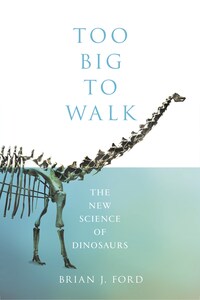William Collins
An imprint of HarperCollinsPublishers
1 London Bridge Street
London SE1 9GF
WilliamCollinsBooks.com
This eBook first published in Great Britain by William Collins in 2018
Text © Brian J. Ford 2018
Photographs © Individual copyright holders
Cover image © Natural History Museum, London/Science Photo Library
Brian J. Ford asserts the moral right to be identified as the author of this work
A catalogue record for this book is available from the British Library
While every eff ort has been made to trace the owners of copyright material reproduced herein, the publishers will be glad to rectify any omissions in future editions.
All rights reserved under International and Pan-American Copyright Conventions. By payment of the required fees, you have been granted the non-exclusive, non-transferable right to access and read the text of this e-book on screen. No part of this text may be reproduced, transmitted, down-loaded, decompiled, reverse engineered, or stored in or introduced into any information storage and retrieval system, in any form or by any means, whether electronic or mechanical, now known or hereinafter invented, without the express written permission of HarperCollins.
Source ISBN: 9780008218904
Ebook Edition © May 2018 ISBN: 9780008218911
Version: 2018-05-01
This is the book I didn’t want to publish. For decades I have deliberated on dinosaurs, and have pondered as the palæontologists slowly revealed their research, and it became increasingly obvious that they were getting dinosaurs wrong. Each year I waited for the truth to dawn. It didn’t happen. The scientific evidence is now clear – the way dinosaurs are explained is incorrect. And so this book has a bold and irreverent aim, for it sets out to demolish our present-day orthodoxies and to create a radical new view of how dinosaurs developed and the way they lived their lives. I am also launching a startling theory which shows how we have misunderstood the Cretaceous period, that great era when the gigantic dinosaurs held sway. Our current understanding is fundamentally misconstrued: the environment was different; the climate was different; the landscape was different. Dinosaurs were different. Everything we know about the age of the dinosaurs is misconceived, and producing this book has been the only way to revolutionize this entire scientific discipline. It has been a colossal undertaking.
We are going to travel back in time to see how the development of our planet was determined, how fossils were discovered, and how science started to understand evolution and the way the world became the way it is. As we set out on this extraordinary journey, I would like to thank the many dinosaur specialists around the world who have assisted with advice. Truly, I’d like to very much; but I cannot. None of them helped – instead, every dinosaur expert has attacked this new theory whenever it has appeared (or tried to). Those palæontologists around the world are so very antagonistic to every word within, that you may have pebbles thrown at your windows if one of them spies this book in your room. This iconoclastic review has been the target of bitter hostility and the most vitriolic insults, though my inquiries into dinosaurs were never intended to be about controversy, but simply about debating how those massive monsters evolved and how they lived their remarkable lives.
There is clearly a requirement for a detailed explanation of dinosaur research. As Larry Witham has pointed out: ‘It is bad news to science museums when four in ten Americans believe humans lived with dinosaurs.’1 There is certainly a need for a survey of the whole field, dating back to prehistory, looking at the pioneers and the early discoveries, and following how opinions have changed over the years.
Why did this study of such colossal creatures capture my attention, since I am a biologist preoccupied by the smallest microscopic living organisms – single cells? Dinosaurs were the largest animals ever, and should be far from my central interests. Yet there is a link between monstrous dinosaurs and microscopic cells. In 1993, Dippy the Diplodocus in the Natural History Museum in London had her tail raised. This long tail had rested on the floor since the skeleton was transferred to the entrance hall in 1979, but research had since shown that the tail could not have been like that in life. And so, in 1993 the massive tail was raised aloft, securely supported by stout steel. People looking at the skeleton found themselves imagining the fossil clothed in muscly flesh, the dinosaur sheathed in warty skin as it snarled at visitors. Not me: I always envisioned a minute microscopic muscle inside the tail, each one endlessly burning glucose to provide metabolic energy at a furious rate as it remained resolutely contracted, struggling to hold the heavy tail up against the downward clutch of gravity. No animal evolves to do this: half the dinosaur’s intake of food would be expended by the effort of simply holding the tail up in the air. Try standing erect with your arms held straight out sideways and see how long you manage. That standard view of dinosaurs was impossible. It was the single cell that proved it.








